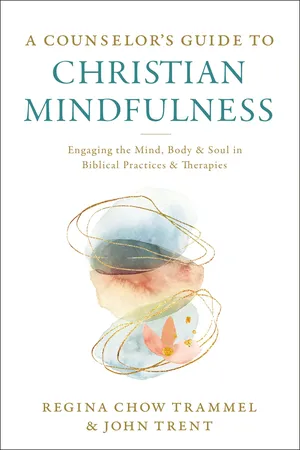CHAPTER 1
Mindfulness versus
Christian Mindfulness
Definition and Historic Roots
When we talk about mindfulness to a person or persons in circles that are largely Christian evangelical, we have observed that there seem to be two lines of thought about it: mindfulness is either too Eastern and therefore should be avoided just like yoga or other Eastern influences, or mindfulness is similar to the contemplative aspect of Christian history. Folks like Father Basil Pennington, Thomas Merton, and Saint Ignatius are often quoted for the latter. What these two differing opinions about mindfulness mean to us—counselors, therapists, and healing professionals—is that there will be clients who may feel wary or skeptical of the practice of it, and there will be clients with some fluency based on their exposure to contemplative thinkers through their books or from spiritual direction courses. However, most folks will say that they like the relaxation or stress relief that mindfulness brings, understanding that mindfulness has been growing in popularity as a response to the general stress and anxiety many people feel.
The popularization of mindfulness is perhaps a symptom of the demands, pressures, and expectations we place on ourselves. We like to be busy. It’s part of our Christian Protestant heritage and ethos of faithful work. We look to the ants, so to speak, to be models of our busy lives (Prov. 6:6–8). However, how many of us give in to the demands of our busy lives and miss the nuggets of truths that God has left us along the way to ponder and store up for ourselves spiritually? Truly, we cannot live on bread alone, but we often do little to contemplate the meaning of God in our lives, and therefore often lack a purpose or an awareness of how God is working in us and through us. We are mindless, rather than mindful of God’s presence and position in our lives.
When we are practicing mindfulness, we are no longer finding our identity and purpose in productivity. Instead, mindfulness helps us to listen and honor the energy (mental, physical, spiritual) that we expend and helps us clarify toward what kingdom purpose we would like to fashion our lives. For you, we hope that the practice of Christian mindfulness enhances your delight in your faith and gives you tools to be the soothing healer that God called you to be for your people. One way to help you delight in your faith in Christ and the mindfulness-skill-building aspects of that faith is to compare historical Christian teachings with popular notions of mindfulness.
Mindfulness originates in Buddhist tenets, and the modern Western mindfulness movement emphasizes a secular or Buddhist worldview. This makes many Christians wary, and rightly so. However, mindfulness has a rich history in our Christian faith as well. The purpose of this book is to provide practical guidance in the Christian practice of mindfulness that is rooted in a biblical worldview.
Nevertheless, understanding basic Buddhist thought around mindfulness can help us to understand the major differences in worldview, which impacts how we can then think about mindfulness through a scriptural worldview.
The Development of Mindfulness in the Secular World
According to Smith (1991), Buddhism began when a wealthy prince living in sixth-century-BC India named Siddhartha Gautama left his wealthy and privileged life to find answers to basic questions about suffering. He began meditating under a bodhi tree and achieved nirvana, which is the end of suffering, or enlightenment, and also ends the cycle of samsara (the Hindu belief that life is a continuous, karmic cycle of birth, death, and rebirth). The Buddha began his ministry thereafter and taught the Four Noble Truths:
1. All life is suffering.
2. Suffering is caused by our cravings in life—the truth is that there is impermanence in life.
3. Detachment to cravings and seeing that we are one will end suffering.
4. The path of cessation of attachment, which is the eightfold path.
It is in the eightfold path that mindfulness is identified. The purpose of such mindfulness is to lead one into enlightenment.
In the 1970s, Dr. Jon Kabat-Zinn, a researcher and well-known author from Massachusetts, popularized mindfulness in the West. His books are bestsellers because he has made the practice of mindfulness palatable to our Western taste. The practice of mindfulness used in his interventions is a secularized version of Buddhist thought on detachment. His work and research contain a few key elements of mindfulness practice, including:
• intentional observation of one’s own thoughts
• use of breath and sitting meditation
• present-moment awareness
• nonjudgment (Kabat-Zinn, 2011)
Kabat-Zinn developed the modern meaning of mindfulness based on his work as a researcher at Massachusetts General Hospital. He defines mindfulness as “the awareness that arises from paying attention on purpose in the present moment nonjudgmentally” (Mindful staff, 2017). Since the 1970s, Kabat-Zinn developed a mindfulness program based on these concepts to address chronic pain in patients at the hospital (Kabat-Zinn, 2011).
He writes, “I like to think of mindfulness as the art of conscious living” (Kabat-Zinn, 1994, p. 6). He eloquently describes the multifaceted cultivation of mindfulness, and ultimately a mindful life, in his bestselling seminal work, Full Catastrophe Living. In his book, he guides the reader and describes the process of dropping into awareness, observing our minds by paying attention to our thoughts. He writes that the observation of our minds lets us see how we often function without thinking, without awareness, leading to living as if we are on autopilot. The awareness cultivated through mindfulness, Kabat-Zinn writes, leads back to ourselves. We know ourselves better, we see the resources and resilience contained within. The wisdom, simplicity, and beauty of life, and appreciation for our human experiences generated by mindfulness practice has no origin, or contains an origin rooted in a different worldview.
Because of Kabat-Zinn’s influence and his work in teaching mindfulness in the United States, there has been an explosion of research around mindfulness. In the fields of psychology, neurology, medicine, and social work, mindfulness has been effectively used to treat depression, anxiety, trauma, chronic pain, anger, and emotional volatility. The outcomes of mindfulness are well documented: improved cognitive flexibility, better emotional regulation, decreased symptoms of stress and anxiety, decreased symptomatology of trauma, enhanced productivity, and better decision-making skills because of less reactivity.
Beginning in the 1970s, Jack Kornfield and Joseph Goldstein, two major figures in the proliferation of mindfulness, founded insight meditation centers (Gethin, 2011). These centers, whose name reflects the “insight” (or the Hindu term, vipassana) emphasized in secular mindfulness, teach key concepts of insight inherent in mindfulness as being in a state of nonjudgment, observing mind and body in the present moment, with the goal of detachment to cravings. According to this line of thought, to be detached is key to finding enlightenment.
Christian Skepticism toward Mindfulness
So why mindfulness? Shouldn’t Christians veer away from this New Age, Eastern religious practice?
For one thing, Christ-centered mindfulness is actually part of our Christian heritage. Centering Prayer, taught by figures such as Thomas Keating and M. Basil Pennington, can be considered a spiritual practice that leads to Christian mindfulness. Lectio Divina, an ancient form of prayer of reading Scripture slowly and deliberately, is an excellent way to infuse your Christian mindfulness practice with the Word of God. Historical figures in the Christian faith who reference the use of Lectio Divina include Basil the Great (329–379 AD), John Cassian (360–435 AD), Gregory the Great (c. 540–640 AD), and Saint Benedict (c. 480–547 AD) (Hall, 2010, p. 145). Though Christians have been skeptical of mindfulness because of its roots outside of Christianity, it is high time to reconnect with these tried and true Christian practices that are based in the Bible’s teaching of silence, stillness, and meditation.
Many popular mindfulness teachers take great pains to differentiate a secular version of mindfulness from a Buddhist one. However, their worldview creeps in. Secular mindfulness practitioners reject organized religion but do not differentiate between the Buddhist-lite approach that remains—breath work, cultivation of awareness and understanding (i.e., enlightenment), and goals toward self-fulfillment, replacing religious understanding with enhanced neurological and behavioral capabilities (e.g., resilience, more adaptable brain connectivity, focus, and work productivity).
Though secular mindfulness practitioners are often humanists, their aims, goals, and values remain: strive toward greater human flourishing on your own individual strength, a guru-based community of mindfulness practitioners to teach you, and the object and aim of the practice likened to Maslow’s hierarchy of needs—toward a self-fulfillment that reflects the concept of enlightenment.
How Christian Mindfulness Deviates from Secular Mindfulness
There are worldview and theological differences between secular or Buddhist mindfulness and a Christian understanding of human nature and our capacity for change through the work of the Holy Spirit. Let’s explore some of these differences before we move forward in our discussion of Christian mindfulness.
The major departure of a Buddhist view of mindfulness from a Christian one is the assumption that human beings are essentially good and have the capacity to strive toward a self-actualized state (nirvana). Christians assume a sinful nature, originating from the first rebellion in the account from Genesis 1. This is an important distinction because as Christian counselors and therapists, we are confronted often by the sinful nature of humanity.
Ultimately, the goals of mindfulness in several main Buddhist traditions are to detach from the world’s sufferings and to find the buddha-nature within (Reeves, 2008). We can call forth God’s wisdom in our clients’ lives but are realistic of the sinful pulls of this world: addictions, disease, mental health problems that wreak havoc in our clients’ lives. It is not the call of the Christian to detach from this suffering. We find compassion and salvation in Christ, who was intimately acquainted with human suffering because he became human. The divine nature of God brings us comfort beca...


